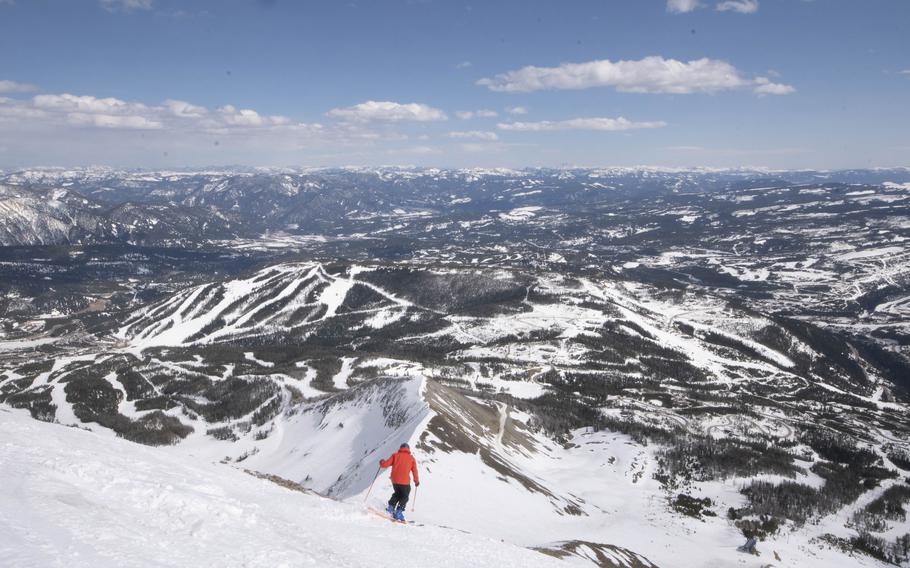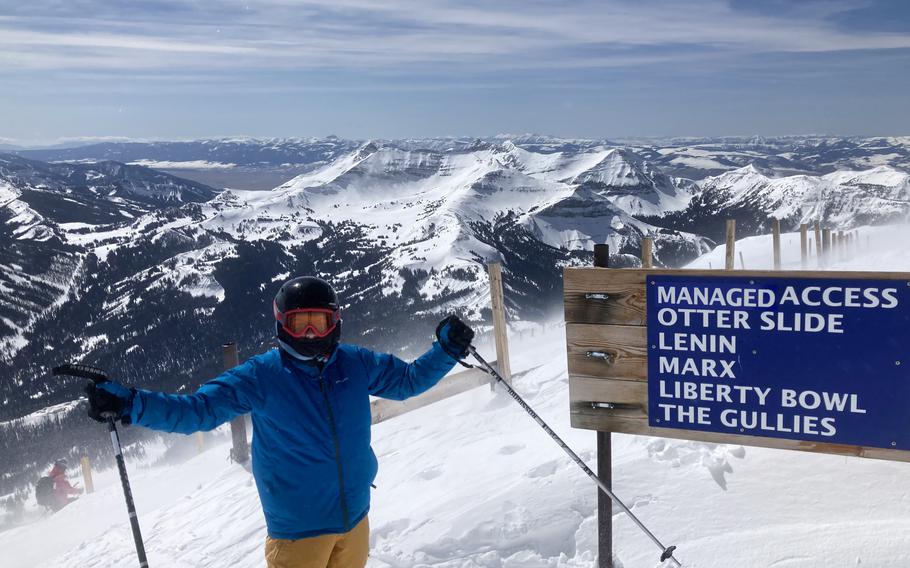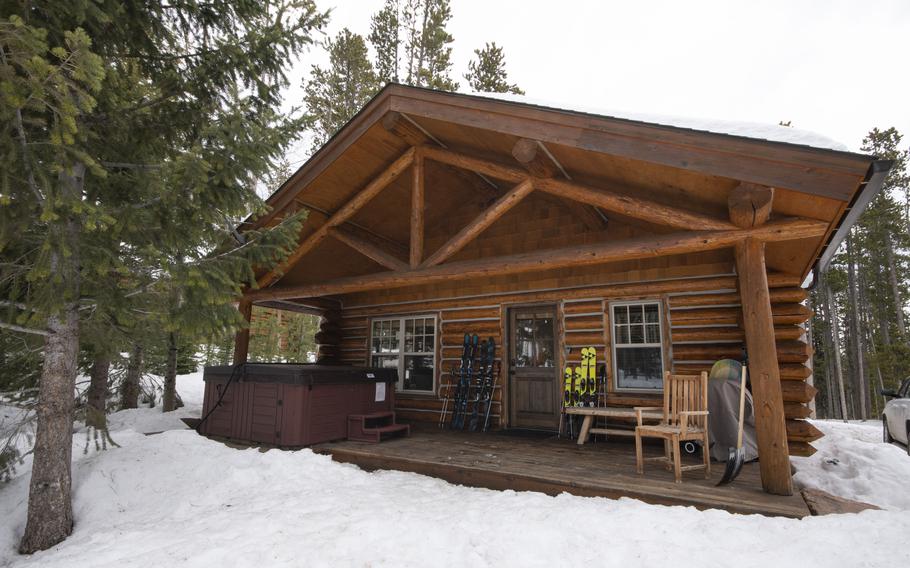
A skier descending Lone Mountain at Big Sky Resort has a commanding view of some of the property’s less-challenging runs far below. (John Briley/For The Washington Post)
The old me would be indignant. I’m at an elevation of 11,000 feet, skittering across a massive bulletproof slate of frozen snow, my ski edges, knees and best-laid plans surrendering together. Twenty years ago, I’d be cursing my luck – I came all the way up here, and no powder?!? – but today, thanks to my age (54), years on skis (50) and the guy in front of me, the biggest ski-movie star you’ve never heard of, I’m content, conditions be damned.
“Well, that was coral reef at its finest,” says Dan Egan when we arrive at a traverse 1,600 vertical feet below our start. “But we had to try.”
Indeed. We’re at Big Sky Resort in southern Montana on an early-April Monday. I’ve come here with my wife, Cathleen, and kids Kai, 12, and Christina, 9, to squeeze a few more days out of a COVID-confounded ski season. Egan, who’s appeared in more Warren Miller ski flicks than almost anyone else and is now a ski instructor and ambassador at Big Sky, is doing far more than helping me unlock this immense resort; he’s also, Yoda-like, coaxing me further down the path to skiing enlightenment.
“So many people come down a run, ski up to me and start telling me what they did wrong,” he says as we wait for Kai on an otherwise empty blue-square run. “But I already know that. I just watched you. I want to hear how much fun you just had, how good it felt to be right here, right now, doing this amazing thing.”
It’s understandable that skiers would want to impress Egan, a mountain-hewn 56-year-old New Englander who shredded the globe as an extreme skier in the 1980s and 1990s, mostly under the banner of Miller, who wrote and narrated 57 ski movies over his own legendary 50-plus-year career. Egan says Miller was kind of a second father to him – a freewheeling yin to his biological dad’s conservative Catholic yang – a backstory Egan summarizes in an illuminating anecdote: “My dad once told me, ‘You can’t ski every mountain and meet every ski bunny in the world.’ When I shared that with Warren, he shrugged and said, ‘Well, we can try!’ “
Egan settled in Big Sky in 2007 for all the right reasons: With 39 lifts fanning out across 5,850 skiable acres and 4,350 feet of vertical drop, the place earns its tagline, the Biggest Skiing in America. (Though, in sheer size, it’s actually second in the United States to Park City Mountain Resort’s 7,300 skiable acres.)

Kai, the author’s son, poses for a photo before his first run down Lone Mountain at Big Sky Resort. (John Briley/For The Washington Post)
We had headed up to that reef, on the south flank of 11,166-foot Lone Mountain, Big Sky’s pyramidal crown, on the thin hope that we’d find soft snow, despite a vicious thaw-freeze cycle over the past 20 hours. It was not an unreasonable quest: The prior day, I had disembarked from the 15-person Lone Peak tram into a gale-force wind, nodded at the arresting view of the Madison Range to the west and dived into a near free fall of willowy, leftover-powder turns.
Today is a new page, of course, and neither the mountain nor Egan could care less.
“Just ski the snow that’s in front of you,” he says after we rip one of the resort’s many long groomers back to the base area. “I was in Park City a couple weeks ago during a storm, and everyone was agitating to get to the top of the mountain, and they’re asking me, ‘Aren’t you coming?’ I had perfectly good powder right under my skis off a beginner lift. Why do I need to stress out looking for something better?”
For 40 years after its founding by newscaster Chet Huntley and its opening in 1973, Big Sky was largely a stress-free zone, dismissed among many destination skiers as a cold, lonely, hard-to-reach mountain with mostly intermediate terrain. Locals, seeking to protect their wintry nirvana, did little to dispel that image. (“Yeah! Big Sky is lonely, cold and, um, it never snows!”)
But Boyne Resorts, which had bought Big Sky in 1976, saw bigger potential. That eventually manifested in the 1995 opening of the tram – which accesses some of the most extreme inbounds territory on the continent – and the 2013 purchase of Moonlight Basin, an adjacent resort with around 1,900 acres of terrain. A marketing push ensued, which coincided with an influx of wealth to the region from the ultra-elite Yellowstone Club, just a short drive away. Then, in 2018, Big Sky was an inaugural participant in the Ikon ski pass, and skier numbers boomed – rising 46% from the 2015-2016 season to 2020-2021.
As you might imagine, this transition has its detractors.
“The golden age is over,” says my friend Andy Harris, who first skied Big Sky in 1992 and has lived in Bozeman since 2015. “Used to be you could get here five minutes before they opened and skate onto a chair. Now, well, we’re never going to be Vail, but . . . there are powder stashes that used to last three days after a storm. Now they’re gone in a morning.”
Sounds like Andy needs a session with Egan, though I did find truth to his grousing: consistent congestion at the tram and at the Swift Current lift at the Mountain Village base, for example, along with some cluelessly entitled behavior around lift lines and ski racks. But, to keep the lights on, a place this big needs more than a few hundred locals with season passes. And the resort is advancing a plan to better manage crowds and add some sorely needed on-mountain dining by 2025. Regardless, once we were above the base area, it often felt as if we had the resort to ourselves.
On a sunny day glazed with thin, wispy clouds, Cathleen and I ride the Thunder Wolf chair (no line) to a wide, ungroomed pitch of soft snow accented sparsely by Douglas fir trees, one long dead and split by wind or lightning, its amber core stark against the white backdrop. Later we take Christina to the far southern reaches of Big Sky and the Lewis & Clark chair (one-minute line), which rises from the Spanish Peaks private club to a broad, rolling slope ideal for a kid looking to progress to the next level.
Kai and I find our most joyous runs off the Challenger chair, specifically the fast, subtle moguls of Midnight down to Moonlight, past dreamily scenic white bark pines and into the woods of Outer Limits and Comet, which drop us onto a cat track. It might seem like a little thing to you, but watching my preteen son ski a line through the woods without falling, whining or asking for route help is on par with bringing home a 4.0 GPA in my book.
The next day, we are with Egan again, stopped on a groomer beneath a row of precipitous chutes, most of which rate triple black diamond. (Yes, that’s a thing in Montana.) I’m gazing up, envisioning bombing down one of them – to wild cheers from Egan! – when he clears his throat paternalistically to regain my attention. He’s drawn a diamond in the corduroy with his ski pole and is tapping at its top point.
“Skiing is a combination of four factors, and it starts with your purpose. Why are you here? What are looking to get out of this? Next is your emotion,” he says, tracing to the next point on the diamond. “How do you feel about skiing? After that is your commitment: how often you ski and the effort you put into it. Once you know all of that, you bring it together and tailor the technique to that person.”
Heady stuff for a vacation, but I’m here to report that it helps. My purpose, obvious though it may sound, is to flirt with the outer edges of my ability and have a ton of fun – ripping through open space, detonating armories of powder in the forest, catching age-appropriate air and stomping landings. By the time my mind arrives at my technique, I no longer care all that much about it. Sure, I could fine-tune a few things, but – reality check – the ship of meaningful improvement sailed years ago. And if I’m going to turn any heads on a ski mountain, especially one that’s home to as many skilled, jaded locals as Big Sky, it’ll be due to a spectacular wipeout, not some hero line.
Later, family reunited over apps and beers at the Montana Jack taproom at the Mountain Village base, the mash-up of Big Sky 2021 is on display. Tables of ruddy-faced tourists are throwing down bourbon shots beneath the glow of the televised NCAA championship basketball game. Out in the cold sunshine of the patio, parents lead wobbly kids from the slopes toward the parking lots, weaving through an assortment of free-ranging dogs and hale locals, who share BYO beers and the deep laughter of the young and the free.
We’d usually hit many more apres and dining spots, but because of the pandemic, we largely stayed out of bars and restaurants, shopping mostly at Roxy’s Market, an amply stocked grocery about seven miles down valley from the resort. For lodging, we split our trip between a Vrbo five minutes past Roxy’s – a small two-bedroom chalet on a secluded property at the end of winding mountain road – and a splurge at a delightful ski-in/ski-out cabin in Moonlight Basin, which has evolved into an exclusive real estate development flanking a private club.

The Cowboy Heaven cabins in the Moonlight Basin area are an attractive lodging option for the ski-in/ski-out location. (John Briley/For The Washington Post)
Between those two stays, we decamped to Yellowstone National Park for three days, about a two-hour drive away. We stayed in the gateway town of Gardiner and, over three dips into the park, saw moose, bison, elk, pronghorn, coyotes, wolves, far-out geothermal formations, our frozen breath on an 11-degree morning and very few other tourists.
Back at Big Sky, I break away from the family and head toward some of the mountain’s most radical offerings: the Headwaters chutes. Getting there requires one of the sketchier boot-packs I’ve ever done, along an icy, knife-edge ridge where the prospect of a catastrophic fall looms large. Fifteen minutes along and with some difficulty due to the slope angle, I reattach my skis and maneuver to the top of Firehole, a triple-black chute that holds a 40-degree pitch throughout much of its 1,000 vertical feet and, toward the bottom, narrows between two rock walls.
I’ve skied a lot of steeps – including Jackson Hole and Taos, Snowbird and Crested Butte – but this is a different level. I am well above tree line, skis edged into the chalky slant like razor blades, and I’m momentarily frozen by the raw Alpine expanse surrounding me. Far below, in Moonlight Basin, skiers float by in the silent distance. I exhale, remembering that I ski – and live – for moments like this, before unweighting my edges and arcing into the void.
IF YOU GO
What to do
Big Sky Resort
50 Big Sky Resort Rd., Big Sky, Mont.
800-548-4486
Huge variety of Alpine skiing – 39 lifts servicing 5,850 skiable acres, including bowls, chutes, steeps, glades, groomers and mogul runs – with ample terrain for skiers of all levels. Buy lift tickets online in advance for best prices. Lift tickets from $69 in lowest season (mid- to late-April) to $225 at the height of the holidays for an adult pass (bit.ly/BigSkyStore). Big Sky is also on the Ikon Pass (from $499 for a limited number of days to $1,149 for unlimited days with no blackout dates (ikonpass.com). The resort also manages a variety of lodging options, from modern and lodge-style hotels in the Mountain Village base area to a pet-friendly hotel 15 minutes away; we stayed at a ski in/ski out Cowboy Heaven cabin in the resort’s Moonlight Basin area.
Yellowstone National Park
2 Officers Row, Yellowstone National Park, Wyo.
307-344-7381
With more than 2.2 million acres covering a variety of ecosystems in Idaho, Montana and Wyoming, Yellowstone National Park offers opportunities to hike, cross-country ski, fish, paddle, sightsee and more. The park is home to iconic wildlife – bison, elk, wolves, bears, moose – and geothermal features, such as geysers and massive mineral formations that visitors can see up close. We stayed in Gardiner, Mont., which afforded quick and easy access to the park and a range of accommodations and dining options. Five entrances: North, Northeast, East, South and West. Annual pass $70, seven-day pass for noncommercial vehicle $35.
Information: visitmt.com